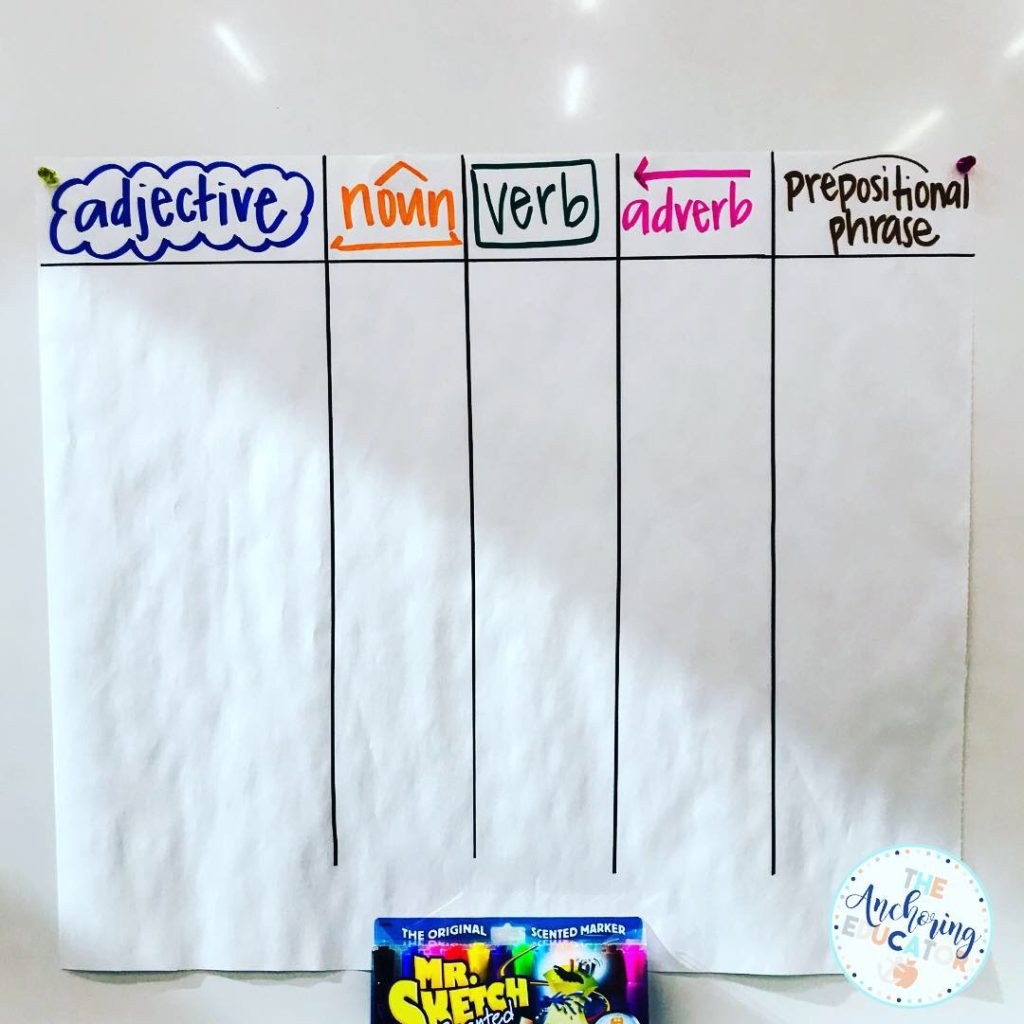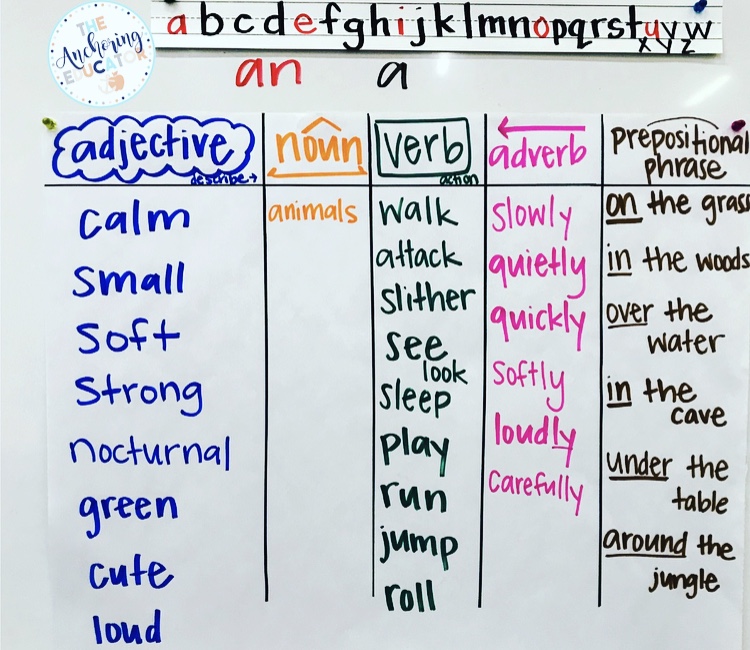The Sentence Patterning Chart is a language acquisition strategy that works wonders for all students, but especially for students who are English language learners or students who are struggling in writing. When developing sentence structure, this sentence patterning chart clearly conveys how a noun and verb work together in a sentence and how adding descriptive words, such as adjectives and adverbs, and expanding sentences using prepositional phrases creates stronger, more descriptive sentences. This aligns with many ELA standards as well as the CA ELD Standards.
The Sentence Patterning Chart is HIGHLY engaging and has a very low affective filer because of the embedded scaffolds! The truth is nothing that I’ve written above or below this sentence matters if your students are not engaged. That is our number one goal as teachers, isn’t it? Let me tell you that students who NEVER participate are on their knees raising their hands as high as possible so that they’re chosen to participate.
Benefits of the Sentence Patterning Chart
- Oral language development when naming parts of speech and sentence chanting
- Vocabulary development through the use of gestures
- Sentence structure/syntax development
- Metacognition when building sentences and ensuring that they MAKE SENSE… although silly sentences can serve a purpose once in a while 😉
- Repetitive practice expanding and enriching sentences
- Multiple opportunities for reading and writing
- Incorporation of phonics and phonemic awareness
- Opportunities for students to present
- Social/Emotional development through cooperative learning and teamwork
- Builds self-esteem using a very low affective filter. ALL STUDENTS FEEL SUCCESSFUL.
- Connections to the topic/unit of study to support reading and writing
Embedded Scaffolds
- Patterning
- Color coding
- Shape coding
- Peer support
- Word banks to assist with generating words
- Sketches/gestures for any and all words whenever possible
Preparing the Sentence Patterning Chart
- Generate and post language objective (i.e. Students will write descriptive sentences about (content/topic) using adjectives, nouns, verbs, [adverbs 2-5], and prepositional phrases in teams.
- Write headings on WHITE chart paper (for color-coding purposes)
- The colors and shapes chosen for each part of speech should be consistent school-wide and through the years.
- Headings for K-1: adjective, noun, verb, prepositional phrase
- Headings for 2-5: adjective, noun, verb, adverb, prepositional phrase

Procedure
1. Sing the parts of speech chant to the “Farmer in the Dell” tune.
- SPC K-1 Chant: adjective adjective noun, adjective adjective noun, adjective adjective adjective noun verb prepositional phrase
Please enjoy my voice 🙂
- SPC 2nd-5th Chant: adjective adjective noun, adjective adjective noun, adjective adjective noun verb adverb prepositional phrase
Please enjoy my voice 🙂

2. Quickly review each part of speech.
3. Teacher selects a noun (person) related to the topic of study. For example, if you’re studying about geology, you might select geologist or astronaut if you’re studying space.
4. Teacher guides students to provide adjectives, verbs and prepositional phrases. For 2nd-5th grade, students also generate adverbs, which is the column that is completed last. If students are having a hard time thinking of words, you can provide gestures or word banks as a scaffold.
5. Teacher selects students to come up and place a sticky note on a word/phrase for each part of speech to create a class sentence. I choose a different student for each part of speech to maximize participation. Once the words are chosen, students can chant the sentence using Farmer in the Dell tune. Generate as many sentences as desired!
Insert –> Student Collaboration
6. As a team, students decide which adjective/verb/adverb/prepositional phrase they want to use and write a sentence of their own on a white sentence strip. Students color/shape code their sentences. Every student on the team is required to write. If students finish this early, they may come up with gestures to match each word in their sentence.

7. Teams present their sentences or sentences with gestures to the rest of their classmates. All students must read together and no student may read upside down.
SPC Extensions
- Read Game: The teacher takes each group’s sentence strip, cuts it up by part of speech and then mixes them up. The teacher then gives each team one adjective, one noun, one verb, one adverb (2-5), and one prepositional phrase. In their same teams, students build a new sentence with proper syntax. The teams then read their new sentence aloud to the class.
- Trade Game: Teacher gives a team a sentence that is missing a part of speech and has double of another part of speech. Then students need to determine what they have that is needed, what is extra and what is missing. Students circulate the classroom as a team to trade with another team until they have built a complete sentence. I like to give them the following sentence frames to encourage maximum use of the language. Do you have an extra (part of speech)? Yes, we have an extra (part of speech).
Integrated Grammar Lesson Ideas
There are numerous integrated grammar lessons that you can teach your students using the Sentence Patterning Chart. I recommend using your ELA language standards as a guide. Here are some ideas:
- Verb tenses: adding -ing, discussing past tense verbs
- To do this, simply cut another piece of white butcher paper to the same size as your verb column, then tape the top together so it acts as a flip chart.
- Subject-verb agreement (i.e. dog plays vs dogs play)
- Cutting the prepositional phrase column off of the poster and moving it to the front, and teaching the comma. (i.e. “Happy dogs play on the grass.” changes to “On the grass, happy dogs play.”)
- Prefixes and suffixes (i.e. suffix -ly can change a root word from an adjective, happy, to an adverb, happily). This can also give you an opportunity to point out irregular words, such as friendly, that serves as an adjective even with the suffix -ly.
- Phonics/phonemic awareness
- Letters vs words vs phrases vs sentences vs paragraphs
THE LIST GOES ON! Use your foundational skills and language standards to see what other grammar lessons you can teach using this chart that is OWNED by the students and RELATED to your current unit of study!
If you’d like to use this strategy in small groups or as independent work once you’re students are familiar with the process, visit my TPT store for a FREE SPC template!
More Language Acquisition Strategies
- Observation Charts
- Launching Collaborative Groups
- Classroom Management Strategy for Vocabulary Development
- Listen, Then Sketch
Leave a comment below to let me know if you’ve tried this strategy before or if you have any further questions about implementation! I’d love to chat with you!
